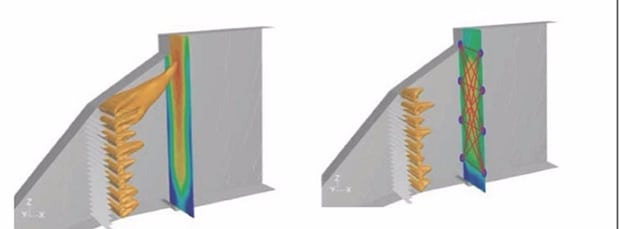New Damage Mechanism Identified in HRSG T-91
For a decade or more, heat recovery steam generator (HRSG) users have heard that Grade-91 tubing (T-91) is susceptible to microstructure damage from improper heat treatment. Now, a new damage mechanism in T-91 tubing has been identified, which HRSG users heard about at the February 2018 HRSG User's Group Conference.
During the discussion on heat transfer components, the new damage mechanism, dubbed "exfoliation," was said to have first shown up as deposits on the steam turbine stop valves at a 500-MW combined cycle plant in the Northeast U.S. When initially discovered, the deposits were attributed to flow-accelerated corrosion (FAC). But lab analysis showed they weren't the magnetite typically associated with FAC, so Intertek specialists were called in to investigate. Further study identified the deposits as spinel, an oxide scale known to occur in fired boilers, where reheater tubes may operate as hot as 1,300F, but not known to occur in HRSGs, where reheater tubes typically operate at only 1,050F.
The reheater tubes in this HRSG, however, operated hotter than that because of supplementary firing. Commonly called duct burners (Figure 1), the supplementary-firing system was raising this HRSG's reheater tube temps to 1,150F-high enough, potentially, to explain the formation of spinel oxides. As a result, Intertek specialists monitored that possibility as the plant cycled through its normal operations. The team observed a very clear process occurring in this HRSG. Spinel oxides would form and adhere tightly to the T-91 tubes until sufficient thickness built up to fracture from the thermal gradients of the plant's cycling operations.
 |
| 1. Duct burners can raise tube temps into the spinel formation zone. Courtesy: John Zink Hamworthy |
As fractured layers broke off, or "exfoliated," they would travel along the steam path and form deposits on the downstream components seeing high steam velocities, such as the steam turbine stop valves. This process occurred over and over: Spinel layers would form, exfoliate, and then reform. Any flow abnormalities-such as water hammer, a leaking attemperator, or a slug of condensate during start up-drove the process more quickly.
To manage the T-91 exfoliation problem, HRSG users should periodically inspect their duct-burner flame patterns, because elongated flames can impinge on, or "lick" the tubes, and raise metal temperatures higher into the spinel-formation zone. An even better tool for monitoring flame patterns is a continuous, online monitoring system, aiming infrared thermography cameras at the plane just upstream of the duct burners (Figure 2). A similar, advanced monitoring tool is passive acoustic mapping, which is an imaging method based on the acoustic emissions received by an array of ultrasonic sensors.
 |
| 2. Infrared thermography is a great way to monitor duct-burner flames. Courtesy: Scientific Engineering Inc. |
-Doug Hilleman, PE is principal engineer with Intertek Group PLC and Rob Swanekamp is executive director of HRSG User's Group Inc.
The post New Damage Mechanism Identified in HRSG T-91 appeared first on POWER Magazine.